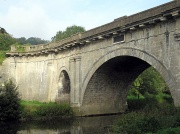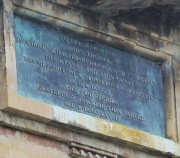Dundas Aqueduct
General
Dundas Aqueduct (grid reference ST785625) carries the Kennet and Avon Canal over the River Avon and the Wessex Main Line railway from Bath to Westbury, near Limpley Stoke in Wiltshire, England.
The aqueduct over the river was built by John Rennie (the elder) and chief engineer (? surely Superintendent of Works) John Thomas (1752-1827), between 1797 and 1801 and completed in 1805. James McIlquham was appointed contractor. It is named after Charles Dundas, the first chairman of the Kennet and Avon Canal Company.
The aqueduct is 150 yards (137.2 m) long with three arches built of Bath Stone, with Doric pilasters, and balustrades at each end. The central semicircular arch spans 64 feet (19.5 m); the two oval side arches span 20 feet (6.1 m). It is a grade I listed building, and was the first canal structure to be designated as an Scheduled Ancient Monument in 1951.
Over many years leaks had developed and it was closed in 1954. For a while in the 1960s and 1970s, the canal was dry and it was possible to walk along the bed on each side of the river as well as through the aqueduct itself. The aqueduct was relined, with polythene and concrete, and restored, reopening in 1984.
The aqueduct is also the junction between the Kennet and Avon Canal and the largely derelict Somerset Coal Canal. The short stretch of the Somerset Coal Canal still with water in it forms Brassknocker Basin, used for boat moorings, cycle hire and a cafe, and is next to Dundas Wharf where the small tollhouse, warehouse and crane still stand. Renovation work is being conducted on the wharf. An 1825 crane is preserved in situ, made by Acraman and Morgan
At the opposite end of the aqueduct a wharf was constructed serving the Conkwell stone quarries.
Aqueduct over Railway
The Wilts, Somerset & Weymouth Railway (taken over by the Great Western Railway) successfully overcame the difficult problem of burrowing through the western abutment of the existing aqueduct in 1857. Today it is difficult to see the results of their work. There is a single portal visible at each end, but beneath the canal it was necessary to have two portals, one for each track.
Nearby Attraction
See Also
Sources of Information
- [1] Wikipedia




